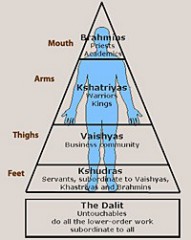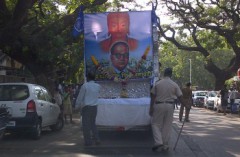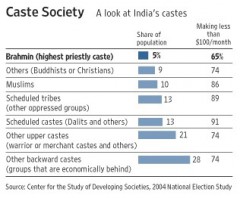11/04/2013
The color doesn't make the Indian!
You feel very funny when your rickshaw driver gets insulted by an Indian girl in a very skin-tight jogging outfit, and that to with the purest American accent! After a few second of stupor comes the moment of solidarity with the driver: What the hell is that woman doing here? And why is she getting so worked up just because we almost ran over her? Then there is a brief moment of solitude: the white girl with Indian reactions, the not-white girl with not-Indian reactions... The world turned upside down!
As a matter of fact, I have been discovering a new species lately: Indians who have grown up abroad. And this species seems to have been growing exponentially; I meet more and more of these ‘freshly landed’ guys. They are funny. They have amazing accents (everything but Indian) and they are sometimes completely lost here (as much if not more than the foreigners of not Indian origin except that it’s weird because it doesn’t match with their skin color).
So who are they? ‘Brains’ coming back? ‘Brains’ just coming? ‘Half-brains’ just coming (see for better understanding the last anecdote below)?
Everybody must have heard of the “brain drain” that India has been suffering from since the 1960s with many Indian ‘brains’ moving to the United States or to Europe (especially to the UK). Well, the American dream. So even if with 11.4 million the number of Indians who leave is high (1)), it only represents 4.3% of the Indian population with a tertiary education (3.5% for France). (2)
However we now speak of ‘brain gain’ and ‘brain circulation’. In 2010, 100,000 Indians are believed to have returned to the mother-land and it made a big noise! (3) However, we are far from a complete change of trend...
To start with, 100,000 out of the 10 million Indian citizens living outside India (1), it's not much. To continue, the same year, more than 150,000 Indian students left to study abroad (4)! Here, it must be highlighted that even if India has made a real effort in the field of education (5), there still not enough places and the quality is debatable. And since almost half of the seats are reserved for the lower castes (representing the same proportion of the population) (6), scoring very high does not guarantee access to the university.
I can quote the girl I met in the line at the Consulate and who would go study medicine in the United States because with the quotas in India, she was almost sure not to get admitted. Abroad seemed the only option, even if it is not the same budget... And that’s also why many students stay there after their studies, to be able to repay their loans (with an American salary).
There is not really any study or government data on the return of Indians to the country. However some believe that the majority (80%) of Indians returnees are less than 35 years. (7) Which corroborates what the ‘new Indians’ I meet say: Abhishek, 30, born in Dubai, came to try his luck in the cinema and his parents are almost ‘horrified’ at the idea of him living in India: “We worked our ass off to get us all out of that rat hole and you want to go back! It’s dirty, it stinks, it is the chaos, blablabla”. They don’t understand... And when it gets too difficult, my friends also wonder what the hell they are doing here!
It is worth mentioning that the ‘brains’ who left several decades ago have been quite successful: the 1 million of Indians in the United States who represents 0.1% of the Indian population earn the equivalent of 10% of the Indian national income. (8) We then understand that they don’t really want to leave...
On the other hand the next generation, their children born outside India and the Indians who have emigrated less than a decade ago, shows a real curiosity towards India. And are scared by the economic uncertainty in the host countries / attracted by the growth opportunities in India.
In the generation of foreigners of Indian origin, there are some ‘brains’ and some ‘normal’ people.
I have been meeting a lot of them, most of all in their thirties and all in India for less than 2 years… There is Jesh, a British insurance guy who came back because his mum had no one left in the UK and she was old and returned to India and got sick, and he hates it here. I met Tosh, a high-end British banker who was sent by his company and would never take a rickshaw and is disgusted by India. I met Naveed who went to work in Dubai for a few years before deciding to try his luck in Bollywood. I met Bob who spent 10 years in the US and was sent by his medical appliance company to take charge of the Asian market and had very Indian reactions sometimes and sometimes very American ones. I met Shuchi who came on holidays, met a work partner and came back to start together a home-designer company. And there is the whole bunch of guys who come and get ‘normal’ Indian jobs waiting for a better opportunity or to start their company…
That’s how I found myself in less than a month with two pursuers (of the latter kind), a Sikh from Buenos Aires and a Keralaite from Manchester, who not only have been flooding me with stupid cheesy whatsaps, they have also sent me photos of their torsos. I still don’t get it...
(1) Since India doesn’t recognise double nationality, many Indians who settle abroad give up on their Indian nationalities. The ones who don’t are called NRI (Non-Resident Indians) and there would be around 10 million of them (against a total of 40 to 100 million ethnic Indians spread across the world). But India has put in place systems to ‘recognise’ people: with the PIO (Person of Indian Origin) card for anyone with parents (up to four generations) or spouse of Indian origin and the OCI (Overseas Citizenship of India) card. The 12 million people holding these cards can stay and work in India without visas (for 15 years for PIO and lifelong for OCI), buy property (except for agricultural land which they can only inherit) but they can’t hold an Indian passport nor vote. And you have people of Indian origin with a foreign passport who just apply for visas like anybody else ! (cf the 35,000 employment visas granted to Americans by India in 2010).
Sources: http://www.nri-worldwide.com/; http://www.immihelp.com/nri/pio-vs-oci.html; Ministry of Overseas Indian Affairs: http://moia.gov.in/writereaddata/pdf/NRISPIOS-Data%2815-06-12%29new.pdf; http://link.springer.com/article/10.1007%2Fs40320-012-0002-3/fulltext.html
(2) In 2000; Source: http://wdi.worldbank.org/table/6.13
(3) Of which 60% are professionals; Source: http://www.rotaryclubofbombay.org/Article.aspx?articleid=0906d154-6b98-4d44-b856-037684af38eb
(4) Still 3 times less than China but three times more than in 2000; source http://www.studyabroad.careers360.com/brain-drain-boon-developed-countries-bane-india
(5) 500 universities and 26,000 "colleges with a total of 13.6 million students in 2012; Source: http://www.unom.ac.in/asc/Pdf/Higher%20Education-1.pdf
(6) Only 16% of Indians have access to tertiary education (55% in developed countries, 11% in developing countries; source: http://www.india-eu-migration.eu/media/CARIM-India-2012%20-%2004.pdf ;) http://www.UGC.AC.in/oldpdf/pub/report/12.PDF
Scheduled Castes (SC) and Tribes (STREAM) constitute approximately 22.5 per cent of the country's population. Accordingly, a pro-rata reservation of 22.5% (SC 15% and ST 7.5%) has been made for them in educational institutions which come under the administrative control of the Ministry of Human Resource Development and other Central Ministries. Seats are also reserved for other categories of the backward community (OBC). The Government of India implemented the following recommendations in 1990 leading to violent protests: the reservation of 27% of the seats in all scientific, technical and professional institutions run by the Central as well as State Governments for other backward communities (CBOs). Source:http://examcrazy.com/education-system/India/Indian-education-reservation-quota-system.asp
(7) http://www.kauffman.org/uploadedfiles/americas_loss.pdf
(8) http://www.india-eu-migration.eu/media/CARIM-India-2012%20-%2004.pdf
08:00 Posted in Expatriation (in India and in other countries), Incredible India!, My stories in India | Permalink | Comments (0) | Tags: india, immigration, emigration, migration, brain drain, brain gain, brain circulation, brain, abroad, skin color, skin complexion, study, statistics, returnees, pio, person of indian origin, oci, nri, overseas indians | ![]() Facebook | |
Facebook | |
10/22/2013
Why in India there is a caste system?
After 7 years in India, I obviously wrote quite a bit on the subject (see below). I have sometimes been revolted against this system. I have accepted it. Ignored it. Forgotten it.
It is not so much this system – let us be realistic, every society is divided in social classes – but its rigidity that disturbs so much… Your caste (which you are born in) defines what you will do, eat, marry etc.
I have never really searched where this system comes from… 
According to ancient Hindu books, human society was created from a body: the Brahmins would come from the head, the Kshatriyas from the hand, the Vaishias from the thighs and the Sudras from the feet. In some versions, the original body would be of a primeval giant, Purusha, sacrificed by the gods to create a human society; in others it would be Brahma.
All animated and inanimated things are believed to possess three qualities, in different proportions: Sattva, Rajas and Tamas. Brahmins would be loaded with Sattva qualities (which include wisdom, intelligence, honesty, goodness and other positive qualities); Kshatriyas and Vaishias with Rajas qualities (passion, pride, valour and other passionate qualities); Sudras with Tamas qualities (dullness, stupidity, lack of creativity and other negative qualities). Hence the different occupations that each people would occupy. And the different diets and different dosages of food they would need to develop their inherent qualities. For instance meat is considered Tamasic food but also Rajasic.
It seems likely to me that these two explanations were developed to support a system with social-historic roots. Which brings us back somewhere around 2000 years BC when the Harappan civilization of the Indus Valley started to decline and the Aryans (Indo-European speakers from Central Asia), a group of warrior nomads began to migrate. There is no agreement between scholars whether “the Aryans and Harappans mixed together and became peaceful, or the Aryans came in as a conquering people, became the ruling class, and instituted the caste system to maintain control”.
However, and this is my personal observation, the stratification of the society in India is clearly linked to the skin colour. The fairer the higher in caste, the smarter, the richer, the more beautiful. At least it is perceived like this. And it’s no new thing. One should see how a baby can stare at a white person. And I have met very few Indians who don’t have, somewhere, an inferiority – totally unjustified and difficult to understand for me – complex toward white skinned. And I don’t think it can only be the result of the British colonisation… Just read old Hindu religious stories: “there are many wars between the good Aryans and the dark skinned demons and devils”.
Somehow the organisation of the Aryans in three groups (the Rajayana which became the Kshatrias (warriors), the Brahmins (priests) and the Vaisias (farmers and craftsmen) , which is pretty logical and easy to adopt, spread on to the local society. Later on, “communities who professed non-polluting jobs were integrated in Sudra Varna and communities who professed polluting professions were made outcasts”.
 So it was convenient for the rules to keep the system that way – as it would be for any ruler in any society. Rules were strict and abided by. Religion (as Hinduism is mostly a canvas of superstitions) was also used to keep everyone on the right track in fear of retaliation. And what makes India different from other countries is that people don’t really rebel against the order of things, and neither does religion decline. They do at times – see how the Untouchable Ambedkar encouraged Hindus to convert to Buddhism in reaction to the caste system, and how such conversions of dalits still happen nowadays, for instance for the 50th anniversary of the leaders’s death* – but fundamentally the society remains the same…
So it was convenient for the rules to keep the system that way – as it would be for any ruler in any society. Rules were strict and abided by. Religion (as Hinduism is mostly a canvas of superstitions) was also used to keep everyone on the right track in fear of retaliation. And what makes India different from other countries is that people don’t really rebel against the order of things, and neither does religion decline. They do at times – see how the Untouchable Ambedkar encouraged Hindus to convert to Buddhism in reaction to the caste system, and how such conversions of dalits still happen nowadays, for instance for the 50th anniversary of the leaders’s death* – but fundamentally the society remains the same…
Is the caste system still present and visible in cities?
“Either it doesn’t really prevails in my world (personal and professional), either it is too subtle for me – at the same time I don’t really dig”.
However read my story of the fat superior Indian giving a lesson to a waiter:
(24/04/2013)
Do Indian people rebel against this system?
“In the countryside, the caste system prevails.
Read the story of Sampat Pal, a shepherdess who, with her Pink Sari gang, rebelled against the injustices inflicted to lower castes by higher castes or to women by men, against corruption and stealing of subsidised food, lands, jobs which the Government reserves for the poorest.”
(20/04/2013)
The issue of castes and quotas in today’s society
“The Indian Constitution prohibits discrimination based on caste.
That said it does not belong to the Government to abolish such a system because it is related to religion. As a matter of fact, the last census (2011) included a (optional) question about the caste.
Casteism is a pillar of Hinduism: "the fulfilment of one personal duty to the caste - and not a universal duty - and the system of reincarnation in a higher or lower caste as a reward for your good or bad actions are the two fundamental pillars of this religion until the final liberation and paradise.")
To fight this discrimination, the Government has implemented quotas for access to education, civil servant positions, political seats. There even has been an untouchable president (K. R. Narayanan).
The problem is that today it is all mixed up and ultimately these quotas are based on the social status (caste) of people but not on the merit or the income. And as low and out-castes form a majority, politicians are struggling to change this system...”
www.indiandacoit.com/archive/2013/04/22/about-casts-and-inequalities-in-india-the-big-picture.html
22/04/2013
What about the lower castes and outcastes? And how do Westerners see it?
 In India people referred to other compatriots as “uneducated” all the time. A term a bit shocking to a French. As the word “backward” to refer to a class of people in the lower castes.
In India people referred to other compatriots as “uneducated” all the time. A term a bit shocking to a French. As the word “backward” to refer to a class of people in the lower castes.
“According to the last census (source: http://www.censusindia.gov.in/2011census) « Intouchables » and the tribes represent 30% of the Hindu population / 24% of the Indian population. And if you add the ‘feet’ (kshudras or lower castes) you get 54% of the population.”
http://www.indiandacoit.com/archive/2011/04/14/and-you-what-s-your-little-name.html#more 04/05/2011
Marc Boulet wrote “In the skin of an Intouchable” – he basically learned Hindi perfectly, took drugs to get a tan and lived on the street as an Intouchable beggar for months…
“Westerners completely fall for it. They rightly fight racism and anti-Semitism but they see the caste system with a lot of indulgence and consider that it is part of the Indian cultural heritage, like the Tâj Mahal. They don’t get shocked, outraged, by the caste system; it is far away. And I also think that their benevolence comes from the fact they admire the brahman civilisation and they get disgusted by sweepers and other untouchables, altogether with beggars and lepers for whom they only think of a contemptuous charity. […] I am not scared of words anymore. The caste system is a segregationist system, just as Apartheid in South Africa. As revolting, as condemnable.”
http://www.indiandacoit.com/archive/2011/05/04/untouchables-again.html
14/04/2011
http://adaniel.tripod.com/origin.htm
http://www.thenagain.info/webchron/india/AryanMig.html
http://www.ambedkar.org/Babasaheb/Why.htm
08:00 Posted in Why in India... | Permalink | Comments (0) | Tags: india, ambedkar, caste, castes, cast system, religion, society, census, lower castes, outcasts, pink sari gang, backward, marc boulet, casteism, hinduism, sattva, rajas, tamas, aryans, fair, skin complexion, white | ![]() Facebook | |
Facebook | |
















